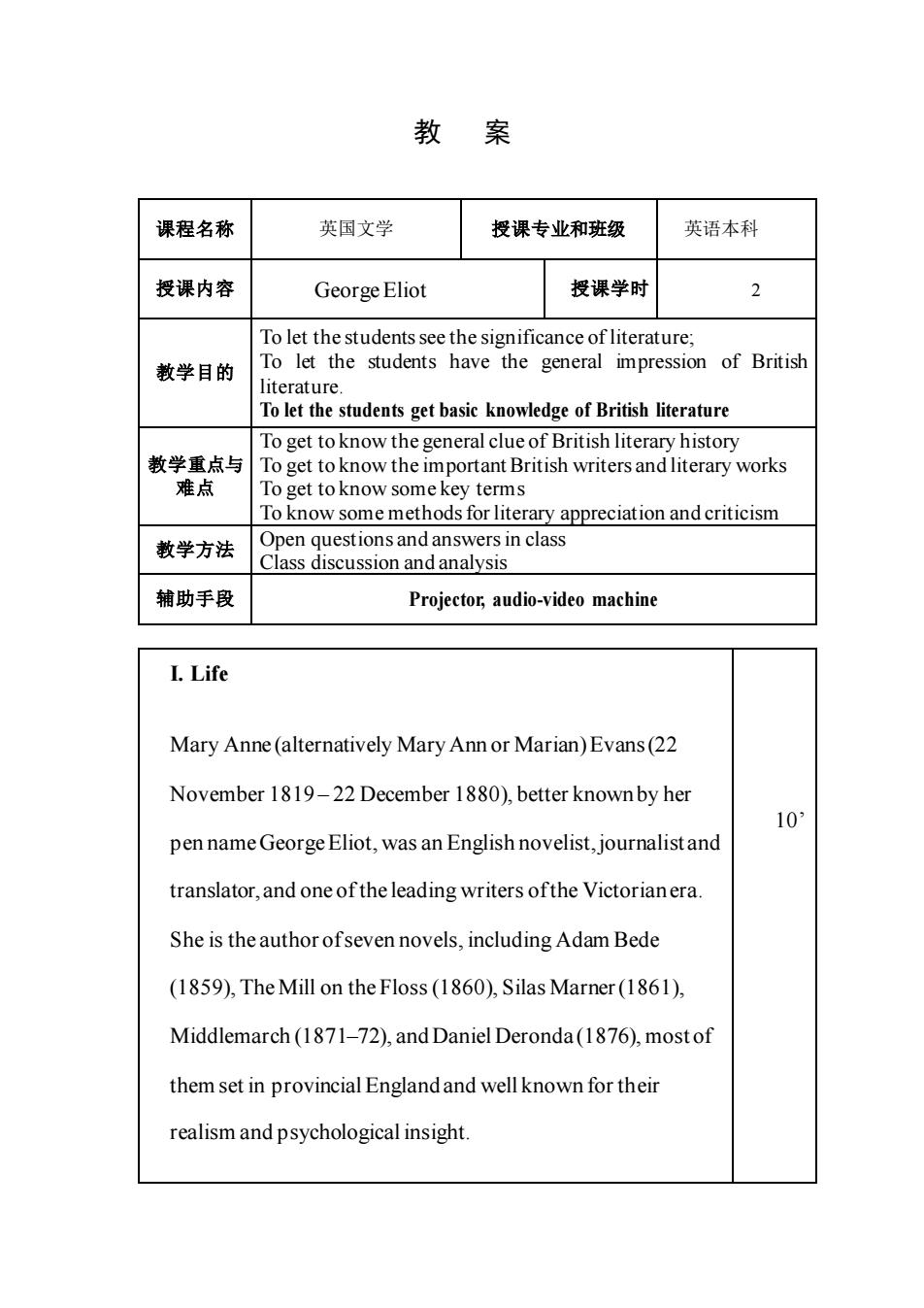
教案 课程名称 英国文学 授课专业和班级 英语本科 授课内容 George Eliot 授课学时 2 To let the students see the significance of literature; 教学目的 To let the students have the general impression of British literature. To let the students get basic knowledge of British literature To get to know the general clue of British literary history 教学重点与 To get to know the important British writers and literary works 难点 To get to know some key terms To know some methods for literary appreciation and criticism 教学方法 s in class 辅助手段 Projector,audio-video machine L.Life Mary Anne(alternatively Mary Ann or Marian)Evans(22 November 1819-22 December 1880),better knownby her 10: pen name George Eliot,was an English novelist,journalistand translator,and one ofthe leading writers ofthe Victorianera. She is the author ofseven novels,including Adam Bede (1859),The Mill on the Floss(1860),Silas Marner(1861), Middlemarch(1871-72),and Daniel Deronda(1876),mostof them set in provincial Englandand well known for their realism and psychological insight
教 案 课程名称 英国文学 授课专业和班级 英语本科 授课内容 George Eliot 授课学时 2 教学目的 To let the students see the significance of literature; To let the students have the general impression of British literature. To let the students get basic knowledge of British literature 教学重点与 难点 To get to know the general clue of British literary history To get to know the important British writers and literary works To get to know some key terms To know some methods for literary appreciation and criticism 教学方法 Open questions and answers in class Class discussion and analysis 辅助手段 Projector, audio-video machine I. Life Mary Anne (alternatively Mary Ann or Marian) Evans (22 November 1819 – 22 December 1880), better known by her pen name George Eliot, was an English novelist, journalist and translator, and one of the leading writers of the Victorian era. She is the author of seven novels, including Adam Bede (1859), The Mill on the Floss (1860), Silas Marner(1861), Middlemarch (1871–72), and Daniel Deronda (1876), most of them set in provincial England and well known for their realism and psychological insight. 10’
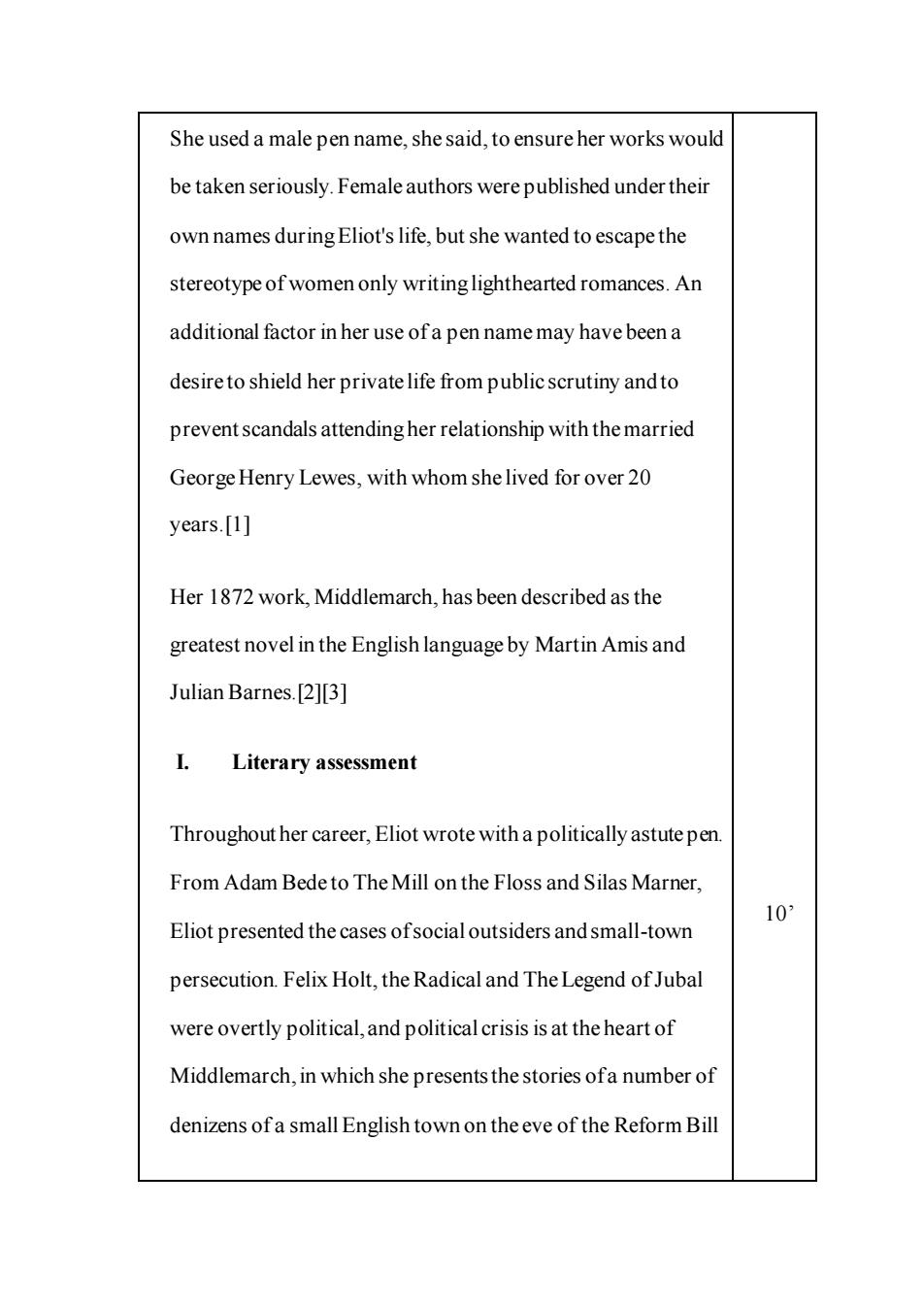
She used a male pen name,she said,to ensure her works would be taken seriously.Female authors were published under their own names during Eliot's life,but she wanted to escape the stereotype of women only writinglighthearted romances.An additional factor in her use ofa pen name may have been a desireto shield her private life from public scrutiny andto prevent scandals attending her relationship with the married George Henry Lewes,with whom she lived for over 20 years.[1] Her 1872 work,Middlemarch,has been described as the greatest novel in the English language by Martin Amis and Julian Barnes.[2][3] Literary assessment Throughout her career,Eliot wrote with a politically astute pen From Adam Bede to The Mill on the Floss and Silas Marner. 10: Eliot presented the cases ofsocial outsiders and small-town persecution.Felix Hot,the Radical and The Legend of Jubal were overtly political,and political crisis is at the heart of Middlemarch,in which she presents the stories ofa number of denizens of a small English town on the eve of the Reform Bill
She used a male pen name, she said, to ensure her works would be taken seriously. Female authors were published under their own names during Eliot's life, but she wanted to escape the stereotype of women only writing lighthearted romances. An additional factor in her use of a pen name may have been a desire to shield her private life from public scrutiny and to prevent scandals attending her relationship with the married George Henry Lewes, with whom she lived for over 20 years.[1] Her 1872 work, Middlemarch, has been described as the greatest novel in the English language by Martin Amis and Julian Barnes.[2][3] I. Literary assessment Throughout her career, Eliot wrote with a politically astute pen. From Adam Bede to The Mill on the Floss and Silas Marner, Eliot presented the cases of social outsiders and small-town persecution. Felix Holt, the Radical and The Legend of Jubal were overtly political, and political crisis is at the heart of Middlemarch, in which she presents the stories of a number of denizens of a small English town on the eve of the Reform Bill 10’
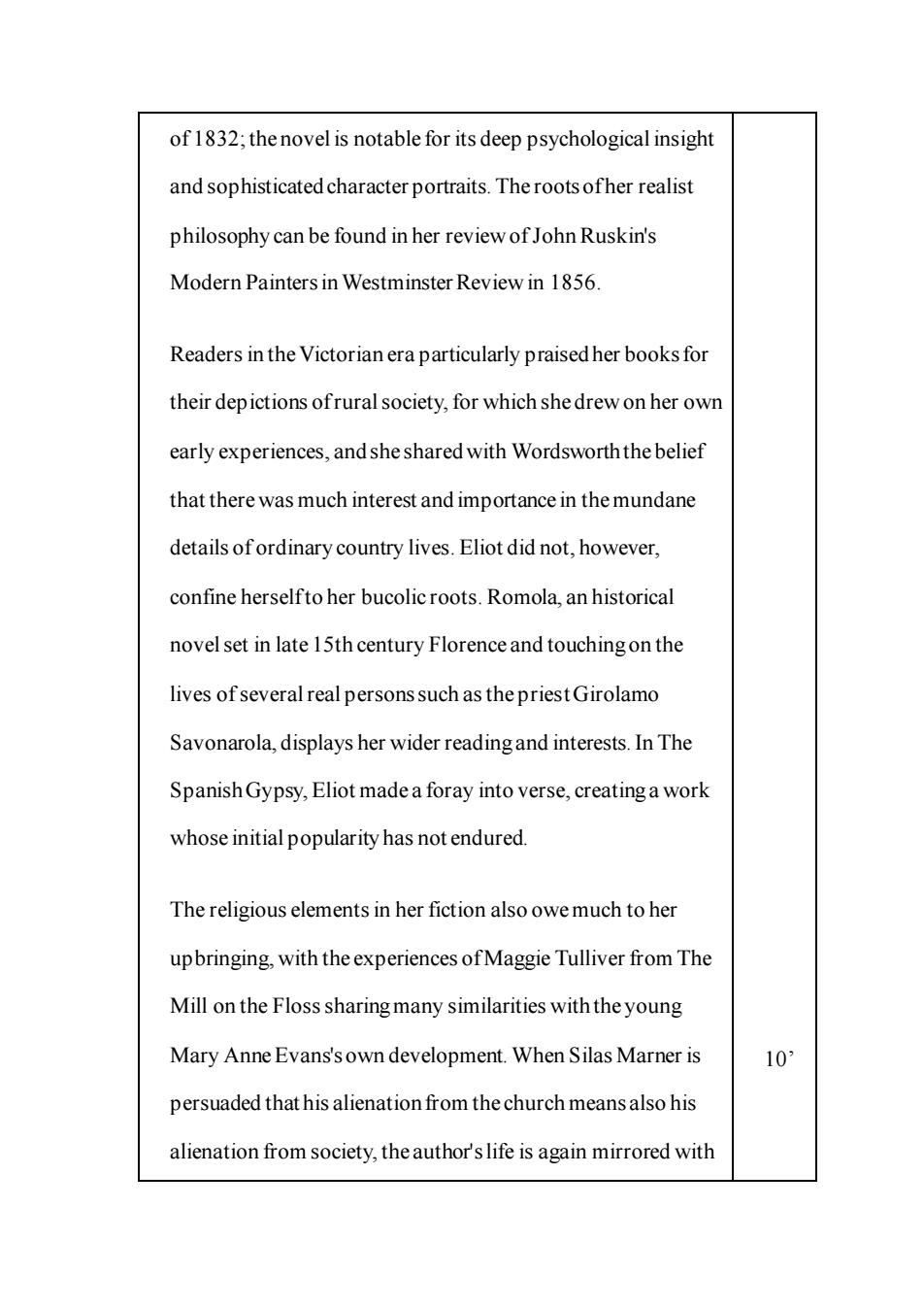
of 1832:thenovel is notable for its deep psychological insight and sophisticated character portraits.Theroots ofher realist philosophy can be found in her review of John Ruskin's Modern Painters in Westminster Review in 1856 Readers in the Victorian era particularly praised her books for their depictions ofrural society.for which she drew on her own early experiences,and she shared with Wordsworththe belief that there was much interest and importance in the mundane details ofordinary country lives.Eliot did not,however, confine herselfto her bucolic roots.Romola,an historical novel set in late 15th century Florence and touchingon the lives of several real persons such as the priest Girolamo Savonarola,displays her wider readingand interests.In The Spanish Gypsy,Eliot made a foray into verse,creatinga work whose initial popularity has not endured. The religious elements in her fiction also owe much to her upbringing,with the experiences of Maggie Tulliver from The Mill on the Floss sharing many similarities withthe young Mary Anne Evans's own development.When Silas Marner is o. persuaded that his alienation from the church meansalso his alienation from society,the author's life is again mirrored with
of 1832; the novel is notable for its deep psychological insight and sophisticated character portraits. The roots of her realist philosophy can be found in her review of John Ruskin's Modern Painters in Westminster Review in 1856. Readers in the Victorian era particularly praised her books for their depictions of rural society, for which she drew on her own early experiences, and she shared with Wordsworth the belief that there was much interest and importance in the mundane details of ordinary country lives. Eliot did not, however, confine herself to her bucolic roots. Romola, an historical novel set in late 15th century Florence and touching on the lives of several real persons such as the priest Girolamo Savonarola, displays her wider reading and interests. In The Spanish Gypsy, Eliot made a foray into verse, creating a work whose initial popularity has not endured. The religious elements in her fiction also owe much to her upbringing, with the experiences of Maggie Tulliver from The Mill on the Floss sharing many similarities with the young Mary Anne Evans's own development. When Silas Marner is persuaded that his alienation from the church means also his alienation from society, the author's life is again mirrored with 10’
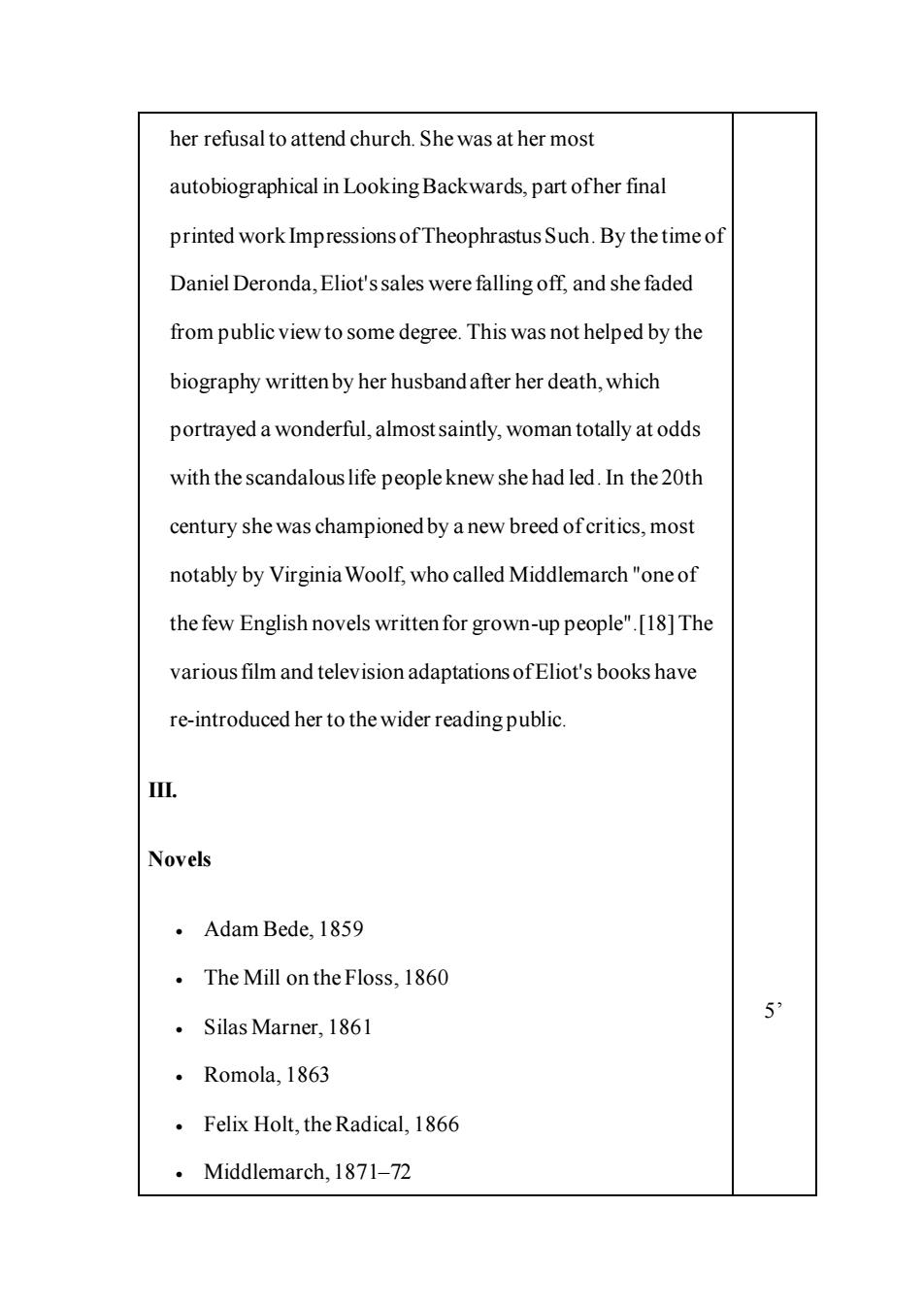
her refusal to attend church.She was at her most autobiographical in Looking Backwards,part ofher final printed work Impressions of Theophrastus Such.By the time of Daniel Deronda,Eliot'ssales were falling off,and she faded from public view to some degree.This was not helped by the biography writtenby her husband after her death,which portrayed a wonderful,almostsaintly,woman totally at odds with the scandalous life people knew she had led.In the 20th century she was championed by a new breed ofcritics,most notably by Virginia Woolf,who called Middlemarch "one of the few English novels written for grown-up people".[18]The various film and television adaptations ofEliot's books have re-introduced her to the wider reading public. II. Novels ·Adam Bede,.1859 The Mill on the Floss,1860 5 Silas Marner,1861 ·Romola,1863 Felix Holt,the Radical,1866 Middlemarch,1871-72
her refusal to attend church. She was at her most autobiographical in Looking Backwards, part of her final printed work Impressions of Theophrastus Such. By the time of Daniel Deronda, Eliot's sales were falling off, and she faded from public view to some degree. This was not helped by the biography written by her husband after her death, which portrayed a wonderful, almost saintly, woman totally at odds with the scandalous life people knew she had led. In the 20th century she was championed by a new breed of critics, most notably by Virginia Woolf, who called Middlemarch "one of the few English novels written for grown-up people".[18]The various film and television adaptations of Eliot's books have re-introduced her to the wider reading public. III. Novels • Adam Bede, 1859 • The Mill on the Floss, 1860 • Silas Marner, 1861 • Romola, 1863 • Felix Holt, the Radical, 1866 • Middlemarch, 1871–72 5’
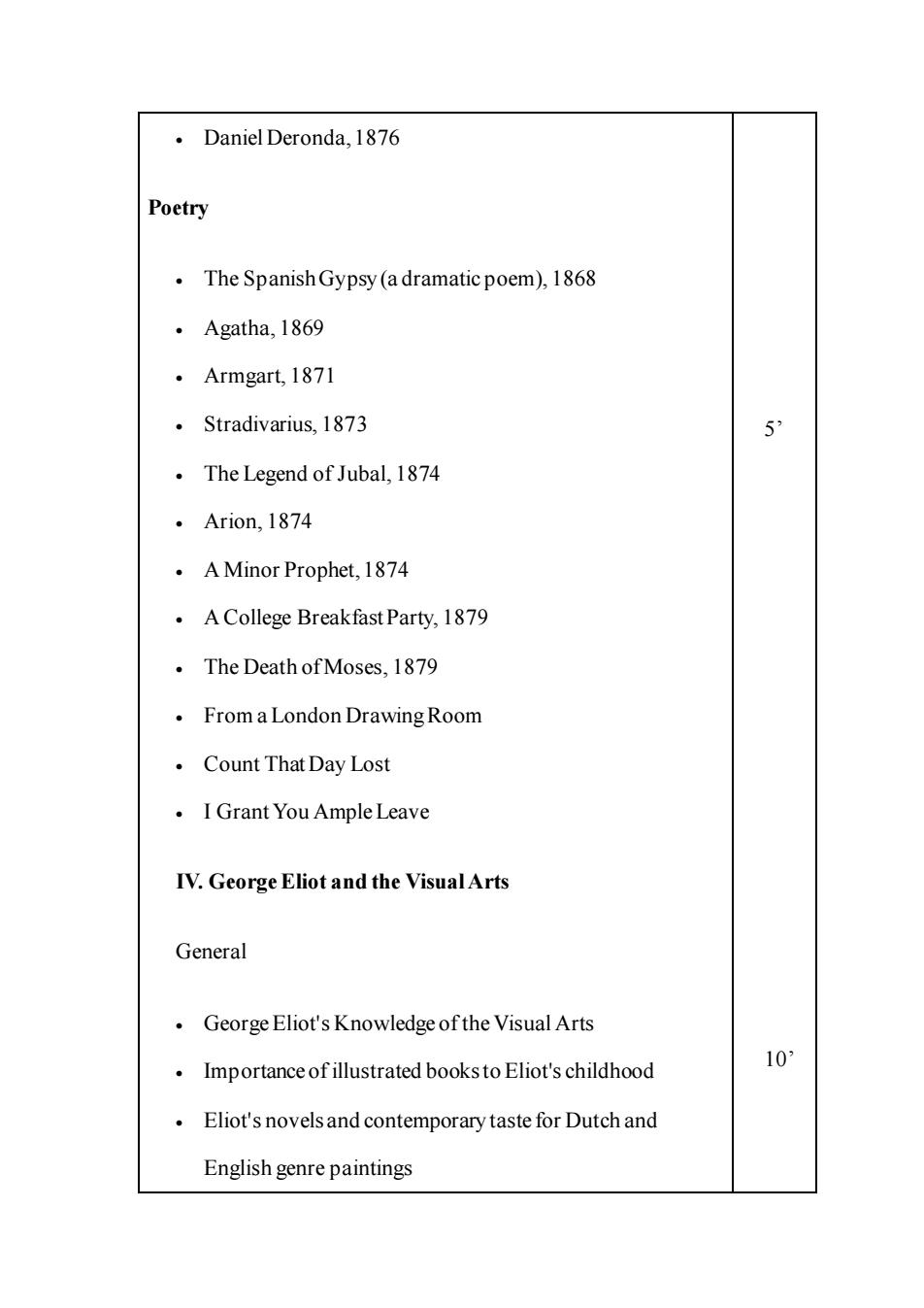
·Daniel Deronda,l876 Poetry The Spanish Gypsy(a dramatic poem),1868 Agatha,1869 。 Armgart,1871 。 Stradivarius.1873 5 The Legend of Jubal,1874 ·Arion,.1874 ·A Minor Prophet,.1874 。 A College Breakfast Party,1879 The Death of Moses,1879 From a London Drawing Room ·Count That Day Lost I Grant You Ample Leave IV.George Eliot and the Visual Arts General George Eliot's Knowledge of the Visual Arts Importance of illustrated books to Eliot's childhood 0, Eliot's novels and contemporary taste for Dutch and English genre paintings
• Daniel Deronda, 1876 Poetry • The Spanish Gypsy (a dramatic poem), 1868 • Agatha, 1869 • Armgart, 1871 • Stradivarius, 1873 • The Legend of Jubal, 1874 • Arion, 1874 • A Minor Prophet, 1874 • A College Breakfast Party, 1879 • The Death of Moses, 1879 • From a London Drawing Room • Count That Day Lost • I Grant You Ample Leave IV. George Eliot and the Visual Arts General • George Eliot's Knowledge of the Visual Arts • Importance of illustrated books to Eliot's childhood • Eliot's novels and contemporary taste for Dutch and English genre paintings 5’ 10’
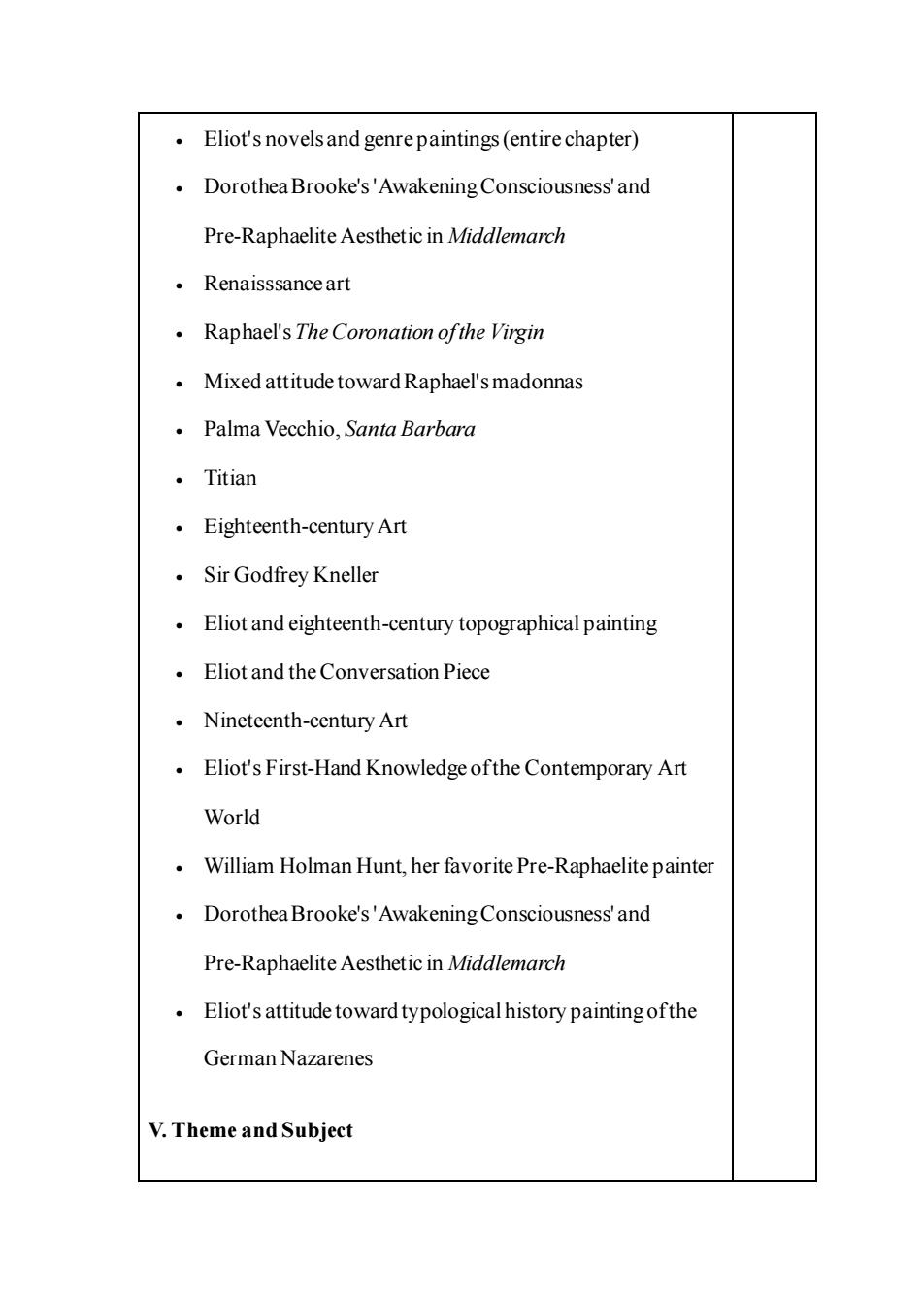
Eliot's novels and genre paintings(entire chapter) 。 Dorothea Brooke's'Awakening Consciousness'and Pre-Raphaelite Aesthetic in Middlemarch Renaisssance art 。 Raphael's The Coronation ofthe Virgin Mixed attitude toward Raphael'smadonnas 。 Palma Vecchio,Santa Barbara 。Titian Eighteenth-century Art ·Sir Godfrey Kneller Eliot and eighteenth-century topographical painting Eliot and the Conversation Piece Nineteenth-century Art Eliot's First-Hand Knowledge ofthe Contemporary Art World 。 William Holman Hunt,her favorite Pre-Raphaelite painter Dorothea Brooke's'Awakening Consciousness'and Pre-Raphaelite Aesthetic in Middlemarch Eliot's attitude toward typological history paintingofthe German Nazarenes V.Theme and Subject
• Eliot's novels and genre paintings(entire chapter) • Dorothea Brooke's 'Awakening Consciousness' and Pre-Raphaelite Aesthetic in Middlemarch • Renaisssance art • Raphael's The Coronation of the Virgin • Mixed attitude toward Raphael's madonnas • Palma Vecchio, Santa Barbara • Titian • Eighteenth-century Art • Sir Godfrey Kneller • Eliot and eighteenth-century topographical painting • Eliot and the Conversation Piece • Nineteenth-century Art • Eliot's First-Hand Knowledge of the Contemporary Art World • William Holman Hunt, her favorite Pre-Raphaelite painter • Dorothea Brooke's 'Awakening Consciousness' and Pre-Raphaelite Aesthetic in Middlemarch • Eliot's attitude toward typological history painting of the German Nazarenes V. Theme and Subject
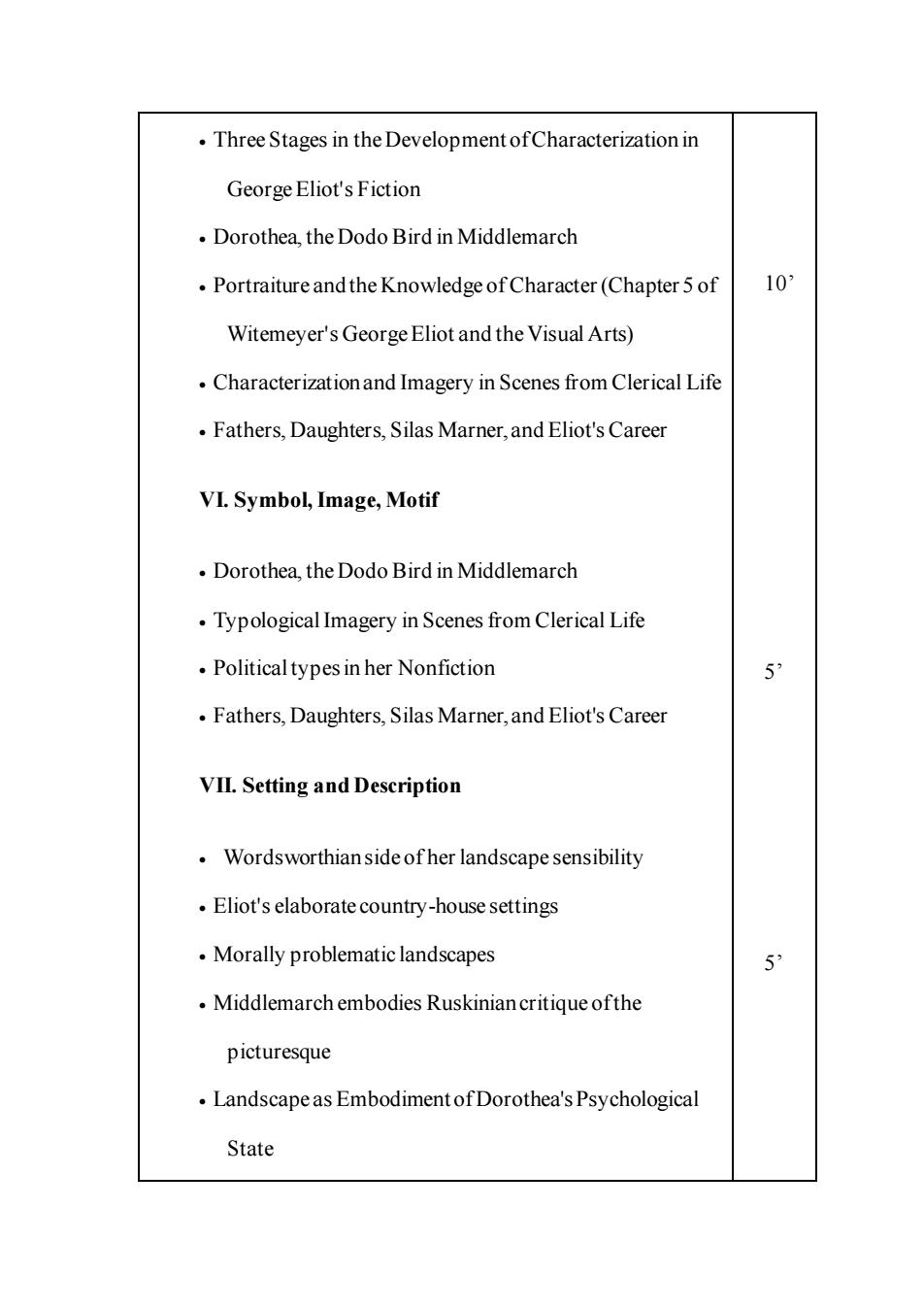
Three Stages in the Development ofCharacterization in George Eliot's Fiction Dorothea,the Dodo Bird in Middlemarch Portraiture and the Knowledge of Character(Chapter 5 of to. Witemeyer's George Eliot and the Visual Arts) Characterizationand Imagery in Scenes from Clerical Life Fathers,Daughters,Silas Marner,and Eliot's Career VI Symbol,Image,Motif Dorothea,the Dodo Bird in Middlemarch .Typological Imagery in Scenes from Clerical Life Politicaltypes in her Nonfiction 5” Fathers,Daughters,Silas Marner,and Eliot's Career VII.Setting and Description Wordsworthianside of her landscape sensibility Eliot's elaborate country-house settings Morally problematic landscapes 5 .Middlemarch embodies Ruskiniancritique ofthe picturesque Landscape as Embodiment of Dorothea's Psychological State
• Three Stages in the Development of Characterization in George Eliot's Fiction • Dorothea, the Dodo Bird in Middlemarch • Portraiture and the Knowledge of Character (Chapter 5 of Witemeyer's George Eliot and the Visual Arts) • Characterization and Imagery in Scenes from Clerical Life • Fathers, Daughters, Silas Marner, and Eliot's Career VI. Symbol, Image, Motif • Dorothea, the Dodo Bird in Middlemarch • Typological Imagery in Scenes from Clerical Life • Political types in her Nonfiction • Fathers, Daughters, Silas Marner, and Eliot's Career VII. Setting and Description • Wordsworthian side of her landscape sensibility • Eliot's elaborate country-house settings • Morally problematic landscapes • Middlemarch embodies Ruskinian critique of the picturesque • Landscape as Embodiment of Dorothea's Psychological State 10’ 5’ 5’
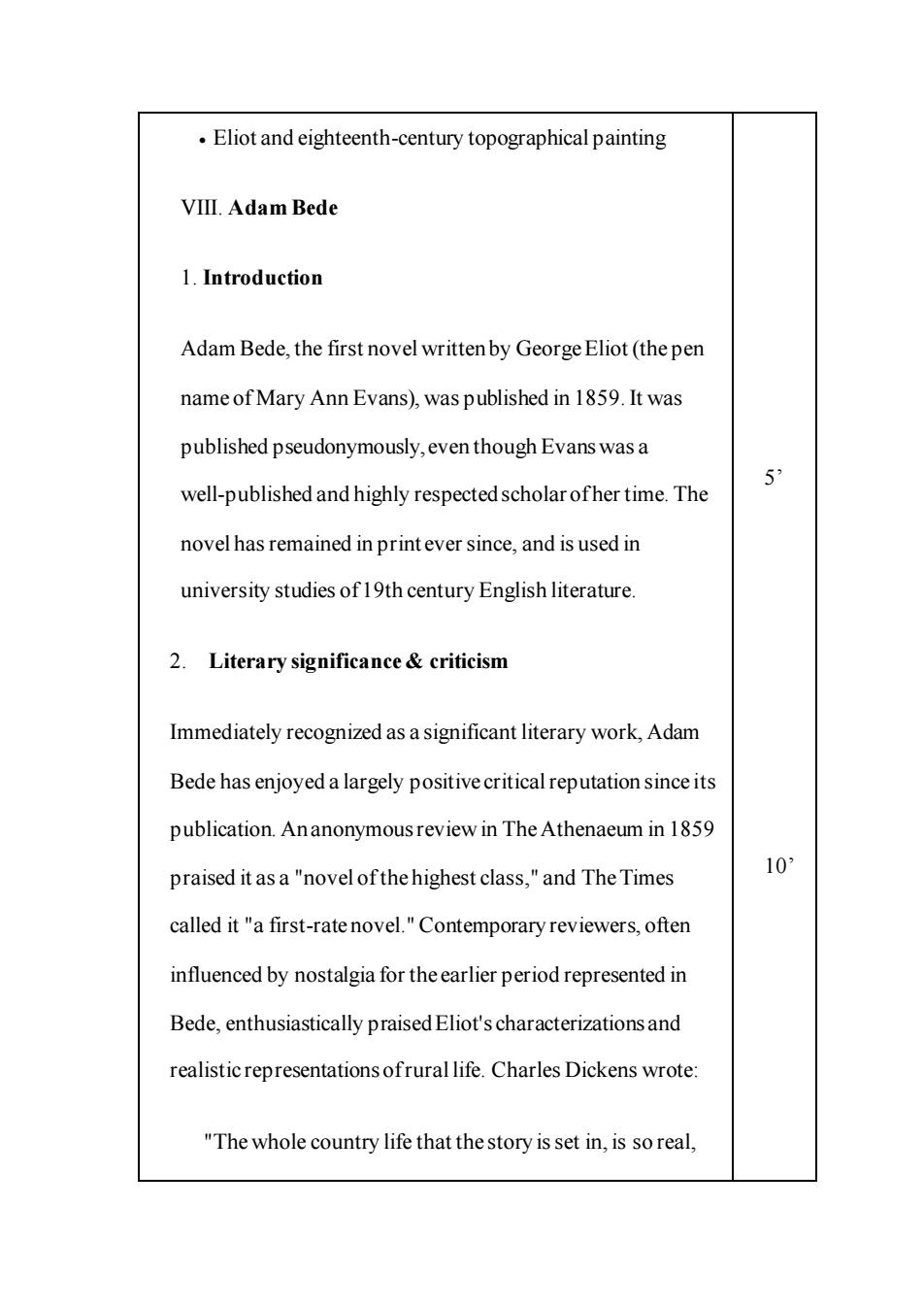
.Eliot and eighteenth-century topographical painting VIⅢ.Adam Bede 1.Introduction Adam Bede,the first novel writtenby George Eliot(the pen name of Mary Ann Evans),was published in 1859.It was published pseudonymouslyeven though Evans wasa well-published and highly respected scholar ofher time.The novel has remained in printever since,and is used in university studies of 19th century English literature. 2. Literary significance criticism Immediately recognized as a significant literary work,Adam Bede has enjoyed a largely positive critical reputation since its publication.Ananonymousreview in The Athenaeum in 1859 praised it as a "novel ofthe highest class,"and The Times 10 called it "a first-ratenovel."Contemporary reviewers,often influenced by nostalgia for theearlier period represented in Bede,enthusiastically praised Eliot's characterizations and realistic representations ofrural life.Charles Dickens wrote "The whole country life that the story is set in,is so real
• Eliot and eighteenth-century topographical painting VIII. Adam Bede 1. Introduction Adam Bede, the first novel written by George Eliot (the pen name of Mary Ann Evans), was published in 1859. It was published pseudonymously, even though Evans was a well-published and highly respected scholar of her time. The novel has remained in print ever since, and is used in university studies of 19th century English literature. 2. Literary significance & criticism Immediately recognized as a significant literary work, Adam Bede has enjoyed a largely positive critical reputation since its publication. An anonymous review in The Athenaeum in 1859 praised it as a "novel of the highest class," and The Times called it "a first-rate novel." Contemporary reviewers, often influenced by nostalgia for the earlier period represented in Bede, enthusiastically praised Eliot's characterizations and realistic representations of rural life. Charles Dickens wrote: "The whole country life that the story is set in, is so real, 5’ 10’
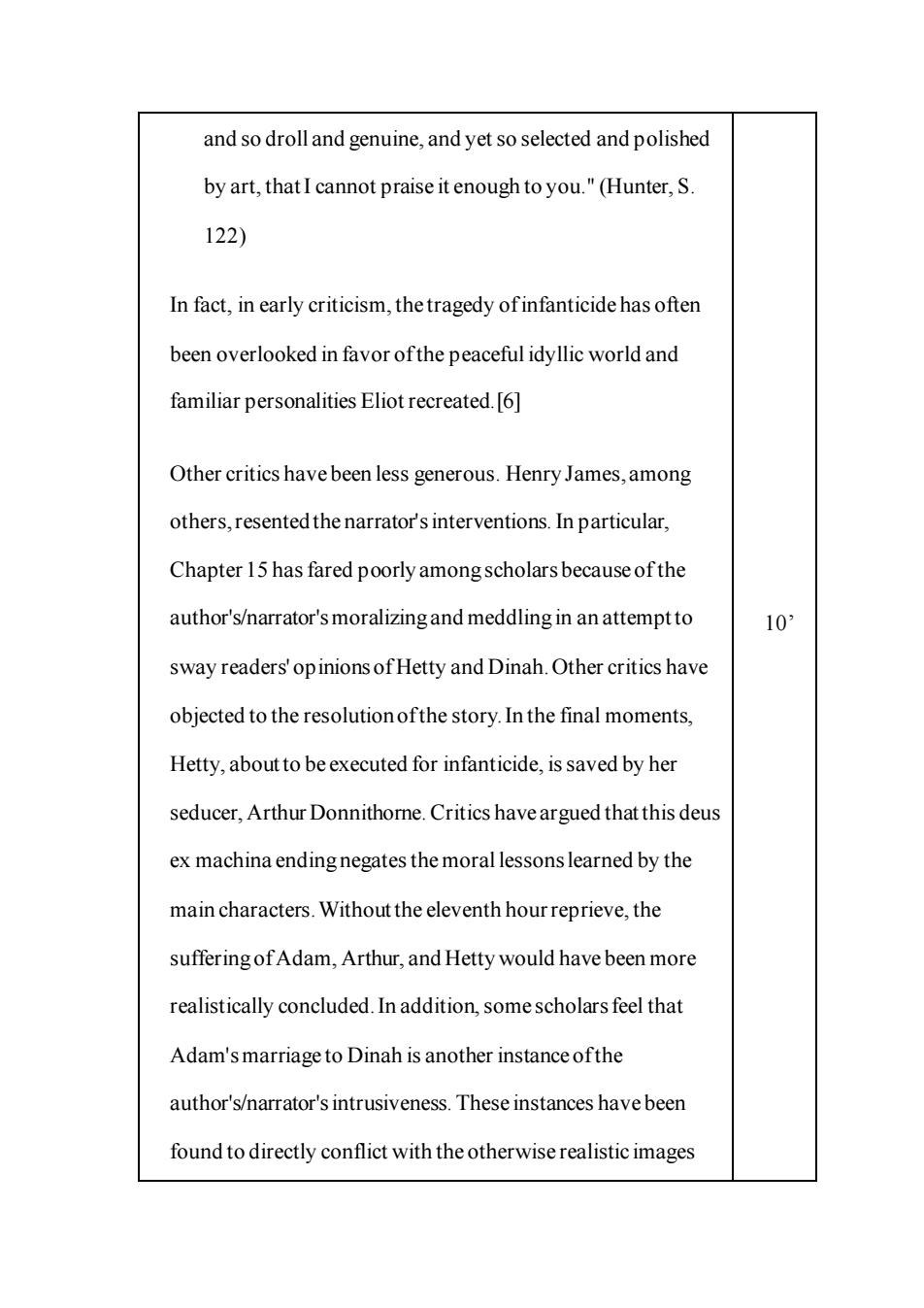
and so droll and genuine,and yet so selected and polished by art,thatI cannot praise it enough to you."(Hunter,S. 122) In fact,in early criticism,the tragedy ofinfanticide has often been overlooked in favor ofthe peaceful idyllic world and familiar personalities Eliot recreated.[6] Other critics have been less generous.Henry James,among others,resented the narrator's interventions.In particular, Chapter 15 has fared poorly amongscholars because ofthe author's/narrator's moralizingand meddling in an attempt to 10: sway readers'opinions of Hetty and Dinah.Other critics have objected to the resolutionofthe story.In the final moments. Hetty,about to be executed for infanticide,is saved by her seducer,Arthur Donnithorne.Critics have argued that this deus ex machina ending negates the moral lessons learned by the main characters.Without the eleventh hour reprieve,the suffering of Adam,Arthur,and Hetty would have been more realistically concluded.In addition,somescholars feel that Adam's marriage to Dinah is another instance ofthe author's/narrator's intrusiveness.These instances have been found to directly conflict with the otherwise realistic images
and so droll and genuine, and yet so selected and polished by art, that I cannot praise it enough to you." (Hunter, S. 122) In fact, in early criticism, the tragedy of infanticide has often been overlooked in favor of the peaceful idyllic world and familiar personalities Eliot recreated.[6] Other critics have been less generous. Henry James, among others, resented the narrator's interventions. In particular, Chapter 15 has fared poorly among scholars because of the author's/narrator's moralizing and meddling in an attempt to sway readers' opinions of Hetty and Dinah. Other critics have objected to the resolution of the story. In the final moments, Hetty, about to be executed for infanticide, is saved by her seducer, Arthur Donnithorne. Critics have argued that this deus ex machina ending negates the moral lessons learned by the main characters. Without the eleventh hour reprieve, the suffering of Adam, Arthur, and Hettywould have been more realistically concluded. In addition, some scholars feel that Adam's marriage to Dinah is another instance of the author's/narrator's intrusiveness. These instances have been found to directly conflict with the otherwise realistic images 10’
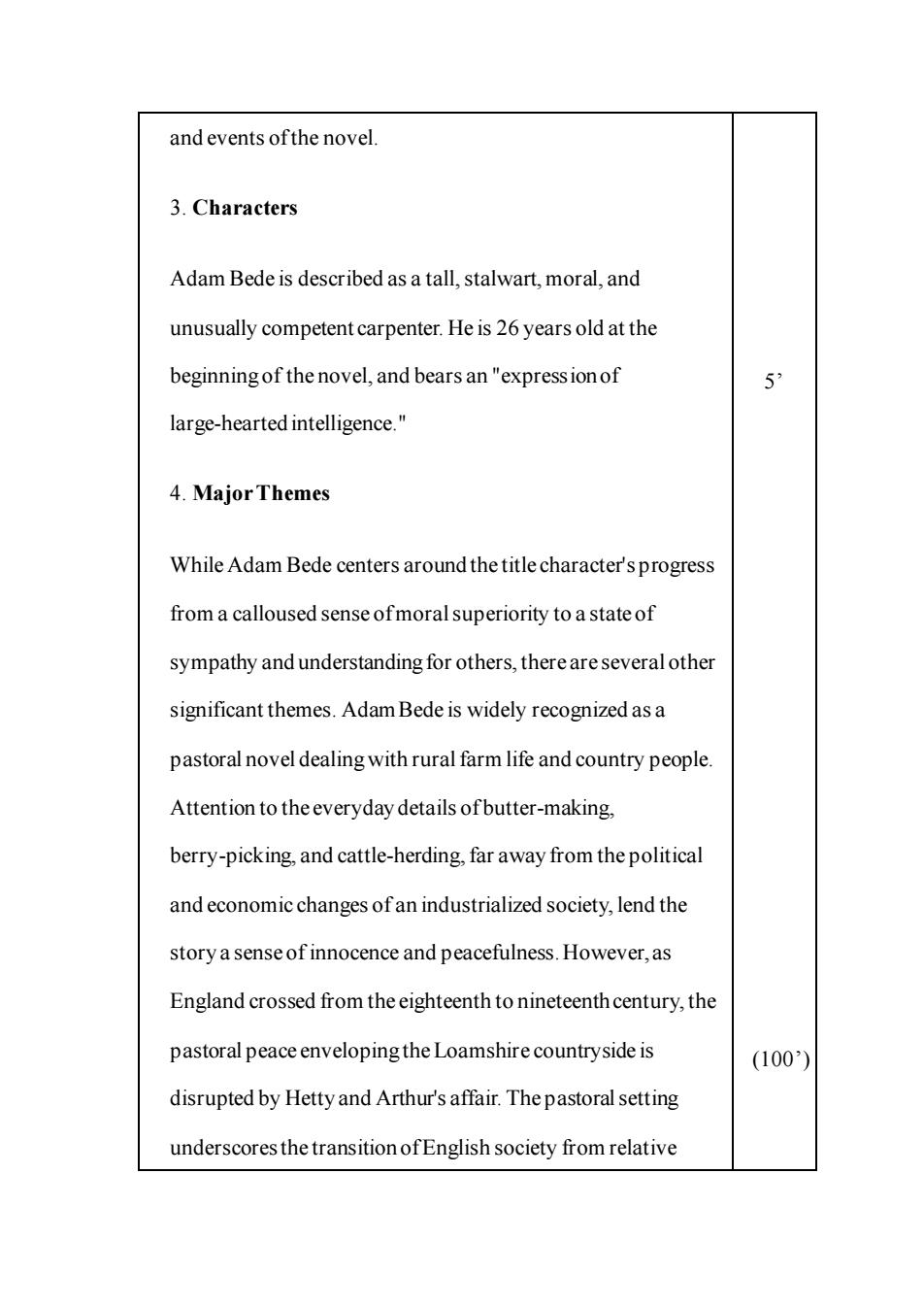
and events ofthe novel. 3.Characters Adam Bede is described as a tall.stalwart,moral.and unusually competent carpenter.He is 26 years old at the beginningof the novel,and bears an"express ion of 5 large-hearted intelligence." 4.MajorThemes While Adam Bede centers around the title character's progress from a calloused sense ofmoral superiority to a state of sympathy and understanding for others,there are several other significant themes.Adam Bede is widely recognized as a pastoral novel dealing with rural country people Attention to the everyday details ofbutter-making, berry-picking,and cattle-herding,far away from the political and economic changes ofan industrialized society,lend the story a sense of innocence and peacefulness.However,as England crossed from the eighteenth to nineteenthcentury,the pastoral peace enveloping the Loamshire countryside is (100 disrupted by Hetty and Arthur's affair.The pastoral setting underscores the transition of English society from relative
and events of the novel. 3. Characters Adam Bede is described as a tall, stalwart, moral, and unusually competent carpenter. He is 26 years old at the beginning of the novel, and bears an "expression of large-hearted intelligence." 4. Major Themes While Adam Bede centers around the title character's progress from a calloused sense of moral superiority to a state of sympathy and understanding for others, there are several other significant themes. Adam Bede is widely recognized as a pastoral novel dealing with rural farm life and country people. Attention to the everyday details of butter-making, berry-picking, and cattle-herding, far away from the political and economic changes of an industrialized society, lend the story a sense of innocence and peacefulness. However, as England crossed from the eighteenth to nineteenth century, the pastoral peace enveloping the Loamshire countryside is disrupted by Hetty and Arthur's affair. The pastoral setting underscores the transition of English society from relative 5’ (100’)